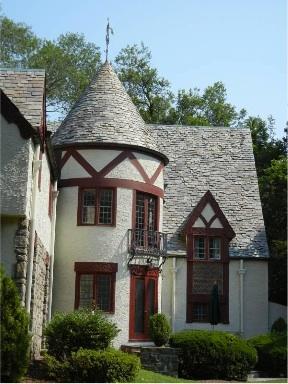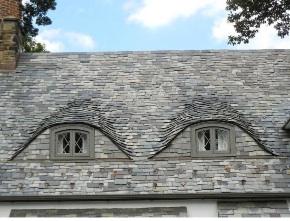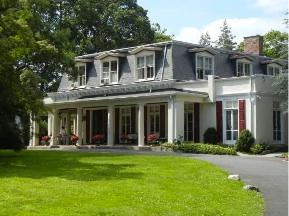New Historic Preservation Code Under Consideration
- Tuesday, 29 April 2014 18:33
- Last Updated: Wednesday, 30 April 2014 09:32
- Published: Tuesday, 29 April 2014 18:33
- Joanne Wallenstein
- Hits: 4748
 The Village Board of Trustees is continuing to work on revisions to a draft of the portion of Village Code concerning historic preservation. Trustee Stacey Brodsky, Chair of the Trustees Law Committee, appeared before the League of Women Voters of Scarsdale on Monday April 28th to update the group on the Board's progress on drafting new preservation code and to clear up misconceptions about the current process.
The Village Board of Trustees is continuing to work on revisions to a draft of the portion of Village Code concerning historic preservation. Trustee Stacey Brodsky, Chair of the Trustees Law Committee, appeared before the League of Women Voters of Scarsdale on Monday April 28th to update the group on the Board's progress on drafting new preservation code and to clear up misconceptions about the current process.
League member Lisa Eisenstein reviewed the current law and lead a discussion about current practice and new proposals under consideration by the Board to safeguard Scarsdale's historic treasures. While some thought these new laws could protect neighborhood character and stymie development, this is not the purpose of the new code that is currently under consideration.
Currently Scarsdale has a reactive process whereby properties are only considered for preservation after an application for demolition has been filed. Since the Village does not currently have a proactive method of land-marking historic properties or resources, these properties are only evaluated if someone wants to take them down.
Under a new law the Village would have a process to identify and designate properties as landmarks.
Here are the criteria in the current draft that would be used by the Committee for Historic Preservation to determine whether to recommend a property for historic designation to the Village Board:
- The depth and significance in American history, architecture, archeology, engineering and culture present in districts, sites, buildings, structures and objects that possess integrity of location, design, setting, materials, workmanship, feeling and association and:
- That the building, structure, site or object in question is associated with events that made a significant contribution to the broad pattern of Village, regional, state or national history or:
- That the building, structure, site or object in question is associated with the lives of significant persons or:
- That the building, structure, site or object in question embodies the distinctive characteristics of a type, period or method of construction or that represent the work of a master, or that possess high artistic values, or that represent a significant and distinguishable entity whose components my lack individual distinction or:
- That the building, structure, site or object in question has been listed on the National Register of Historic Places or NYS Register of Historic Places or Westchester County Inventory of Historic Places. A National, State or County listing is not alone sufficient to warrant designation as a landmark.
Unlike current practice, the Committee for Historic Preservation could be proactive about identifying sites or  properties that meet these criteria. They would make their reccommendation to the Village Board who would have the power to impose it. Owner consent would not be required, as the committee reasons that ownership is transitory and the current owners might not concur with what the Village Board deems best for Scarsdale.
properties that meet these criteria. They would make their reccommendation to the Village Board who would have the power to impose it. Owner consent would not be required, as the committee reasons that ownership is transitory and the current owners might not concur with what the Village Board deems best for Scarsdale.
However, under the new statute, renovations would be permitted as long as the essential elements of the façade that make the building historic are maintained. The trustees reason that only the building façade is of public interest and the landmark designation would not govern interior renovations or improvements. Owners of landmarked properties would be required to maintain the features that are historic such as architectural symmetry, materials, rooflines or any other historic elements. A newly formed "Design Review Board" comprised of members of the CHP and BAR would review and approve renovation plans for historic properties.
There would be a tax incentive for any improvements on a land-marked property and following a renovation, the new assessed value would be phased in on a sliding scale over a 10-year period to curb tax increases for renovations of historic properties. Brodsky did not envision that a land-marked home would suffer a decrease in value, as owners would still be permitted to renovate a home to today's standards, and the designation might give the home distinction or cache.
 Brodsky said that these new criteria for land marking are more stringent and that only a modest number of sites and homes would meet them. She envisioned that buildings like the Scarsdale Woman's Club, the Scarsdale Library or Wayside Cottage might be the first to be considered. The new criteria could not be used to protect a home simply because neighbors don't want to see it torn down. For example if a home without any architectural significance belonged to someone well known, the fame of the prior tenant alone would not be enough to landmark the house.
Brodsky said that these new criteria for land marking are more stringent and that only a modest number of sites and homes would meet them. She envisioned that buildings like the Scarsdale Woman's Club, the Scarsdale Library or Wayside Cottage might be the first to be considered. The new criteria could not be used to protect a home simply because neighbors don't want to see it torn down. For example if a home without any architectural significance belonged to someone well known, the fame of the prior tenant alone would not be enough to landmark the house.
Brodsky also sought to clear up confusion about buildings that had been identified in the Historic Resources Survey conducted by Li/Salzman Architects and presented to the Village in 2012. Brodsky explained that the properties that were identified in the reconnaissance survey have not been landmarked. The architects did a survey of the Village and called out certain homes and districts for consideration. However, nothing has been done to date to landmark these properties and a more thorough research study would be needed before the CHP could designate properties as historic.
One provision of the proposed draft should please former Village Trustee Robert Harrison. The new law would require the CHP to make all decisions at public meetings pursuant to the NYS Open Meetings Law. Currently the CHP does their deliberations behind closed doors, a policy to which Harrison frequently objects.
For now, no new law has been passed. Until then, if a property is to be demolished, an application needs to be  filed and the Committee For Historic Preservation will consider the appropriateness under the current criteria.
filed and the Committee For Historic Preservation will consider the appropriateness under the current criteria.
Some hoped that this new law would prevent teardowns and limit the size of new homes on Village properties. Brodsky explained that the historic preservation law would not address this concern. However, the Board of Trustees has asked the Planning Board to to look into treating gravel driveways as impermeable (as they are for storm water purposes) for purposes of lot coverage, which would affect the size of houses on properties. Driveways are currently considered permeable surfaces (like grass) and therefore their area does not count when calculating the maximum size house on a property. The Board of Trustees may also reconsider the FAR calculation, which was implemented 10 years ago and may not be doing enough to prevent over-sized houses from being built on existing lots.










